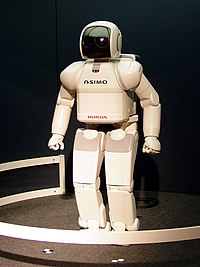
Photo from wikipedia
Abstract Improving the accuracy of parallel kinematic machines (PKMs) for practical applications remains a significant challenge. This paper focuses on reducing the PKM's tracking error caused by the deformations in… Click to show full abstract
Abstract Improving the accuracy of parallel kinematic machines (PKMs) for practical applications remains a significant challenge. This paper focuses on reducing the PKM's tracking error caused by the deformations in its kinematic chains by introducing redundancy. A novel 3-DOF planar redundant PKM, which has a redundant chain with both actuation and kinematic redundancies, is designed and serves as the object of study. Regarding the deformations of PKM kinematic chains as the structural errors, the general tracking error model is first established on the basis of kinematic analysis. The concise PKM dynamic model is then derived by using the Newton-Euler method to obtain the constraint forces and inertial loads of each kinematic chain for calculating their deformations. The redundant force applied by the redundant chain can be controlled actively and its size and direction are all optimized to reduce the PKM tracking error with consideration of the mechanical constraint and the limitation on the maximum angular velocity of the redundant chain. Finally, simulation results are provided to verify the effectiveness of the redundant force optimization method in improving the tracking accuracy of the redundant PKM.
Journal Title: Mechanism and Machine Theory
Year Published: 2018
Link to full text (if available)
Share on Social Media: Sign Up to like & get
recommendations!